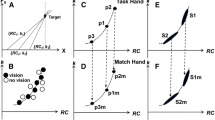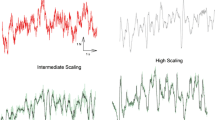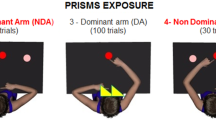Summary
This experiment was designed to investigate the influence of a secondary attention-demanding force-production task on adaptation to prismatic displacement. Recent suggestions by Finke (1979) lead to the prediction that a secondary task executed during adaptation would interfere with the central component of adaptation (as measured by intermanual transfer), but not the peripheral component (adaptation specific to adapted limb). There were three secondary task conditions (no task, easy task, difficult task). Other factors investigated were: type of feedback (continuous, terminal), hand adapted (right, left) and prism orientation (base right, base left). While negative aftereffect was not influenced by the secondary task manipulation, intermanual transfer results provide partial support for Finke's model. Correlational analyses indicate the importance of task-specific parameters in determining the nature of perceptual-motor adaptation.
Similar content being viewed by others
References
Allport DA, Antonis B, Reynolds F (1972) On the division of attention: A disproof of the single channel hypothesis. Quart J Exp Psychol 24:225–235
Baily JS (1972) Adaptation to prisms: Do proprioceptive changes mediate adapted behavior with ballistic arm movements? Quart J Exp Psychol 24:8–20
Brooks LR (1968) Spatial and verbal components of the act of recall. Canad Psychol 22:349–368
Cohen MM (1967) Continuous versus terminal visual feedback in prism aftereffects. Percept Mot Skills 24:1295–1302
Finke RA (1979) The functional equivalence of images and errors of movement. Cogn Psychol 11:235–264
Finke RA (1980) Levels of equivalence in imagery and perception. Psychol Rev 87:113–132
Foley JE, McChesney J (1976) The selective utilization of information in the optical array. Psychol Res 38:251–265
Graybiel AM, Held R (1970) Prismatic adaptation under scotopic and photopic conditions. J Exp Psychol 85:16–22
Harris CS (1965) Perceptual adaptation to inverted, reversed and displaced vision. Psychol Rev 72:414–444
Held R (1965) Plasticity in sensori-motor systems. Sci Am 213:84–94
Held R (1968) Dissociation of visual functions by deprivation and rearrangement. Psychol Forsch 31:338–348
Kelso JAS, Stelmach GE (1976) Central and peripheral mechanisms in motor control. In: Stelmach GE (ed) Motor control: Issues and trends. Academic Press, New York, pp 1–40
Kerr B (1973) Processing demands during mental operations. Mem Cognit 1:401–412
Kinsbourne M, Hicks RE (1978) Functional cerebral space: A model for overflow, transfer and interference effects in human performance. In: Requin J (ed) Attention and Performance VII. Academic Press, New York, pp 345–362
Kornheiser AS (2976) Adaptation to laterally displaced vision: a review. Psychol Bull 83:783–816
McCloskey DI (1978) Kinesthetic sensibility. Physiol Rev 58:763–820
Navon D, Gopher D (1979) On the economy of the human-processing system. Psychol Rev 86:214–255
Trevarthen CB (1968) Two mechanisms of vision in primates. Psychol Forsch 31:299–337
Welch RB (1972) The effect of experienced limb identity upon adaptation to simulated displacement of the visual field. Percept Psychophys 12:453–456
Welch RE (1978) Perceptual modification: Adapting to altered sensory environments. Academic Press, New York
Welch RE, Choe CS, Heinrich (1974) Evidence for a three-component model of prism adaptation. J Exp Psychol 103:700–705
Welch RB, Goldstein G (1972) Prism adaptation and brain damage. Neuropsychologia 10:387–394
Wilkinson DA (1971) Visual-motor control loop: A linear system? J Exp Psychol 89:250–257
Author information
Authors and Affiliations
Rights and permissions
About this article
Cite this article
Elliott, D., Roy, E.A. & Allard, F. The influence of a secondary task and type of feedback on adaptation to lateral displacement of the visual array. Psychol. Res 44, 343–353 (1982). https://doi.org/10.1007/BF00309329
Received:
Published:
Issue Date:
DOI: https://doi.org/10.1007/BF00309329




